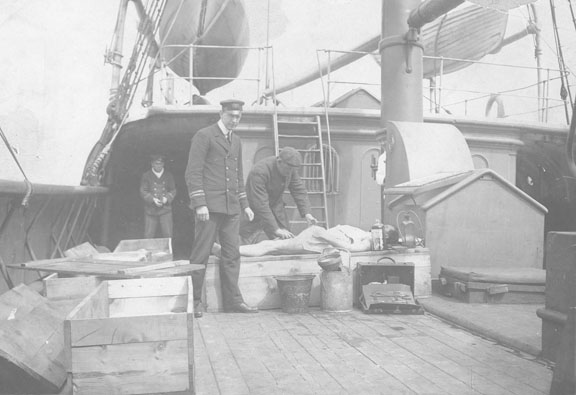Nova Scotia Archives
Halifax and Its People / 1749-1999
"Body of RMS Titanic victim aboard rescue vessel [CS Minia] being made ready for make-shift coffin", April or May 1912
The loss of the RMS Titanic needs no introduction to anyone living today in the Halifax Regional Municipality. The great liner suffered irreversible damage, after a glancing blow from an iceberg at 11:40 p.m. on 14 April 1912 opened five water-tight compartments to the in-rushing sea. At 2:20 a.m. the following day, the technological marvel of the Edwardian Age sank. Of the 2228 passengers and crew on board, 1518 lost their lives. Within hours, the RMS Carpathia recovered 710 passengers at the scene; five were dead or subsequently died on board and were buried at sea. The Halifax-based cable ships MacKay-Bennett and Minia were chartered within days, steamed to the site, and recovered the majority of the remaining bodies – 306 by the MacKay-Bennett and 17 by the Minia. Altogether, some 337 bodies were plucked from the Atlantic, with the CGS Montmagney, the SS Algerine, the RMS Oceanic and the SS Ilford also assisting. One hundred and twenty-eight bodies were buried at sea and 209 brought to Halifax. Of the latter, 59 were claimed and shipped to other locations; the remaining 150 were buried at Fairview Lawn, Mount Olivet and Baron de Hirsch cemeteries.
Photographer: attributed to William J. Parker
Date: May 1912
Reference: Nova Scotia Archives Photo Drawer - Transportation & Communication - Ships & Shipping - Titanic, no. 2 / negative: N-0715

